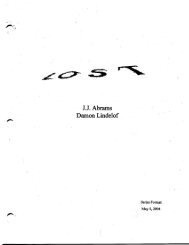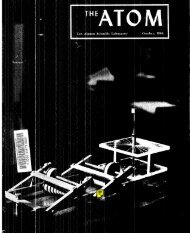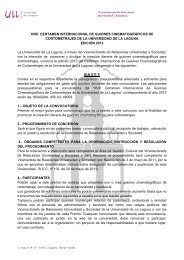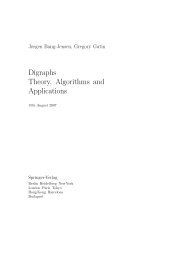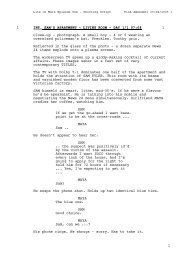Create successful ePaper yourself
Turn your PDF publications into a flip-book with our unique Google optimized e-Paper software.
8120<br />
By the statement of the problem,<br />
the two odd numbers in question are<br />
different-otherwise, their product<br />
wouldbe equal to the square of their<br />
half-sum. So the smallest possible<br />
product is 1 1 . 13 : l43j the next one<br />
is 11 . 15 = 165. Since there are no<br />
pyramids as high as 165 m, the nuinbers<br />
are I I and 13, and the height of<br />
the pyramid is greater than 143 m<br />
but less than [(11 + L3ll2l2:144rr,.<br />
There are two pyramids in Egypt<br />
higher than 143 m: the pyramid of<br />
Khufu (Cheops) at 146.6 m and that<br />
of Khafre (Chephren) at 143.5 m. So<br />
the pyramid was built for Chephren.<br />
Iilings<br />
l. For figure 3a in the article the<br />
answer is I llmn+ 1); forfigure 3b it's<br />
I llmn - 1). In both cases the answer<br />
is obtained by extending the grid of<br />
the small parallelograms and counting<br />
nodes inside the big parallelogram.<br />
2.It canbe proved that the points<br />
A, B, C and the intersection points<br />
of AA' BBr, ar,dCCrcanbe considered<br />
nodes of a parallelogram grid<br />
(fig. 12). Then the arca of ABC<br />
equals 3 + 3' 116 = 3% times the<br />
area of a grid parallelogram, while<br />
the area of the small (shaded) triangle<br />
is LlZ of this unit. So the answer<br />
is ll2 + 3/, = /7 .<br />
The existence of the parallelogram<br />
grid in the solution above can<br />
be derived, for example, from the<br />
fact that the segments AA' BBr,<br />
CC, divide each other in theiatio 3<br />
:3 : 1. A proof is left to the reader.<br />
3. Let's tile the plane with copies<br />
Figure 12<br />
Figure 13<br />
of the given big square with the<br />
small square inside it (fig. 13). This<br />
creates blue and red hexagons (we<br />
see them in the top part of the figure),<br />
and we have to prove they are<br />
of equal area. |oin the small squares<br />
as shown. Then a "thick" grid consisting<br />
of small squares and parallelograms<br />
joining them emerges (see<br />
the lower part of the figure). Obviously<br />
this grid fits on itself when<br />
rotated 90' about the center of any<br />
small square. Therefore, the paral-<br />
Ielograms are all congruent to one<br />
another and divide the plane into<br />
squares. Each of these squares consists<br />
of two blue and two pink triangles<br />
with a common vertex, and,<br />
as was mentioned in the article, the<br />
two blue triangies have the same<br />
total area as the two pink ones.<br />
Now, looking at the hexagons again,<br />
we see that a blue one comprises<br />
two blue triangles and a parallelogram,<br />
and a pink one consists of two<br />
pink triangles and a parallelogram. It<br />
follows that the hexagons have the<br />
same areal and we're done.<br />
4.Let M and Nbe the midpoints<br />
of the sides AB and CD of a quadrilateral<br />
ABCD. Think of ABCD as a<br />
tile in a quadrilateral tiling of the<br />
sort considered in the article. Let<br />
CDEF be an adjacent tile (symmetric<br />
to ABCD about N), and I be the<br />
midpoint of its side EF (fig. 14). Since<br />
M andl are symmetric about N, all<br />
these three points lie on one line, so<br />
ML = MN + NL:zMN. On the other<br />
hand, ML = AE. Now the statement<br />
of the problem follows from the Triangle<br />
Inequality for ttiangle ADE<br />
Figure 14<br />
and the relation DE = BC.<br />
5. We use the fact that the area ot<br />
a parallelogram is less than half the<br />
product of its diagonals, and is equal<br />
to this product only if the diagonals<br />
are perpendicular. We can see this, for<br />
example, by looking at the four triangles<br />
formed by a parallelogram and<br />
its diagonals. We can then use the<br />
facts that the area of a triangle is half<br />
the product of two adjacent sides and<br />
the sine of the included angle, and<br />
that this sine is at most equal to I<br />
(when the diagonals are perpendicular).<br />
Consider the given quadrilateral<br />
ABCD as a sample tile, the corresponding<br />
tiiing and the paralleiogram<br />
tiling associated with it. The area of<br />
any of the parallelograms is twice the<br />
areaof.ABCD, and it's no greater than<br />
the half-product of the diagonals of<br />
the parallelogram. As seen in figure<br />
14, one of the diagonals, AE a AD +<br />
DE = AD + BC. Similarly, the other<br />
diagonal is not greater thanAB + CD.<br />
So the areaof ABCD does not exceed<br />
%Ao+BCI(AB+cDl.<br />
To obtain equality, we must have<br />
AD + BC = AE, or AD ll BC andAB ll<br />
CDi in addition, the diagonals of the<br />
parallelogram must be perpenficular.<br />
This means that AB CD is a rectangle.<br />
6.Infigure 15, the areaof ABCDis<br />
twice the area of APDQ (because<br />
\---><br />
Figure 15<br />
0uAr/TUlll/ilJSIttRS, tltirrS & S0t lJil0ils 53



